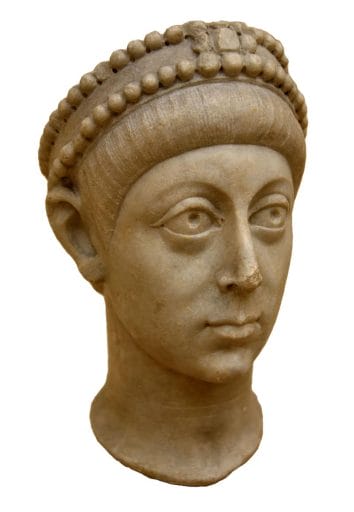Last Updated on December 25, 2021 by Vladimir Vulic
Life: AD c. 377 – 408

- Name: Flavius Arcadius
- Born AD ca. 377 in Spain.
- Became emperor January AD 395.
- Wife: Aelia Eudoxia; (one son Theodosius)
- Died at Constantinople, AD 408.
Arcadius was born in Spain around AD 377, the son of Theodosius the Great and Aelia Flavia Flaccilla.
His father raised him to the rank of co-Augustus of the east in AD 383, though due to his young age it was a solely ceremonial title at first.
But when in AD 395 Theodosius died, Arcadius succeeded him as emperor of the east at the age of eighteen. Meanwhile his brother Honorius became emperor of the west.
This division of the empire into eastern and western parts was the decisive one, which sent the two on separate ways. Had the empire effectively been split by Valentinian, it had still functioned as a unit. One of the two emperors had always enjoyed seniority over the other. However, the accession of Arcadius and Honorius is widely seen as the division of the Roman empire into two completely separate parts.
Arcadius is therefore often quoted as the first ‘Byzantine’ ruler.
Though at first it was not so much Arcadius who held the reins of power, but the praetorian prefect of the east, Flavius Rufinus.
Rufinus was a determined Christian who passed severe laws against pagans, heretics and adulterers.
His attempt to marry his daughter off to Arcadius and so further cement his power failed, as the emperor instead married Aelia Eudoxia, who was the daughter of the Frankish general Bauto.
Whilst Rufinus was the strong man in the east, Stilicho, the man left in charge to guard over the affairs of young Honorius, effectively controlled the west.
Both were highly ambitious, unscrupulous men and Stilicho claimed that he had been asked by the late Theodosius not only to guard over Honorius but so too, at least in part, over Arcadius.
This meant it almost impossible for the two powers behind the thrones to avoid conflict sooner or later.
The inevitable collision of the two came about as the Visigoths under the leadership of Alaric rebelled in their territory in which Theodosius had settled them along the Danube. The barbarians smashed their way through the Balkans into Macedonia and Greece, devastating all that was in their path.
Stilicho now intervened, marching into northern Greece (and thereby crossing the line between the two empires, as defined by Theodosius).
This all appeared to be a plan of Stilicho’s to take over the prefecture of Illyricum (roughly consisting of the diocese of Moesiae as defined by Diocletian), which by Theodosius had been defined as part of the eastern empire.
But Rufinus protested against this infringement and demanded Stilicho’s immediate withdrawal. Surprisingly Stilicho withdrew, leaving behind, under the command of his Gothic general Gainas, several legions which were to be restored to eastern command.
Gainas marched these troops to Constantinople where Rufinus awaited them, apparently expecting to be hailed Augustus himself by the troops. But instead he met with a violent death, being stabbed to death by soldiers of the newly arrived army.
It appears obvious that this was a plot of Stilicho’s and it did irreparable damage to the relationship between the eastern and the western empire.
The position of Rufinus as ‘power behind the throne’ now fell to Eutropius, an old, bald eunuch, who was the court chamberlain at Constantinople.
Despite markedly strained relations, in AD 397 the east, weakened by the Visigoth rampage, asked Stilicho to intervene anew and aide them against Alaric. Stilicho did intervene, but in Greece Alaric managed to avoid being pinned down by his forces and escape from Greece unharmed.
Eutropius saw in this Stilicho’s intent of letting Constantinople’s greatest menace run free, so that he could continue harassing the east. Angrily he declared Stilicho a public enemy.
Meanwhile the threat of Alaric was such that Eutropius bribed him to make peace by making him ‘Master of Soldiers’ in the Balkans.
Next came in the same year (AD 397) an uprising in Africa led by the military commander called Gildo.
Gildo revolted against the western empire, of which his territory was a part and declared his allegiance to the eastern throne instead.
This though meant that the valuable African grain supply to Rome fell into the hands of the east.
Clearly this had been the work of Eutropius, who had connived with the rebels.
Stilicho was not prepared to accept this, though he did not follow the manyfold advice of starting an open war with the east. Instead he engaged in systematic diplomatic intrigue which eventually, in AD 399, saw Eutropius discredited, thrown from office and banished into exile.
The vacant position of government now (AD 400) fell to a certain Gainas and after six months to Arcadius’ strong-minded wife Aelia Eudoxia, who received the rank of Augusta.
In January AD 402 Arcadius’ son Theodosius II was elevated to the rank of Augustus at the age of one.
Eudoxia now encouraged Alaric to act against the west. The Goth did so in AD 403, invading Italy and terrifying its population until Stilicho could drive him back out.
In about AD 404 Eudoxia died due to a miscarriage and Arcadius’ government fell to the praetorian prefect Anthemius.
Then in AD 408 Arcadius died a natural death, having never really ruled his own empire.

Historian Franco Cavazzi dedicated hundreds of hours of his life to creating this website, roman-empire.net as a trove of educational material on this fascinating period of history. His work has been cited in a number of textbooks on the Roman Empire and mentioned on numerous publications such as the New York Times, PBS, The Guardian, and many more.
